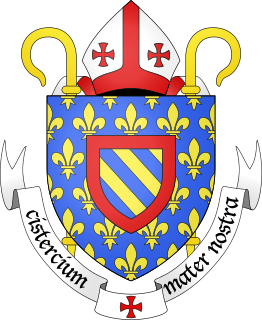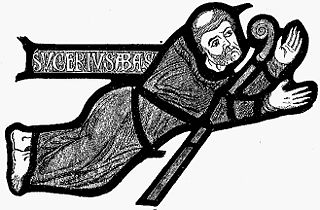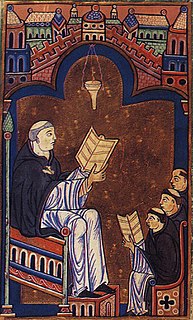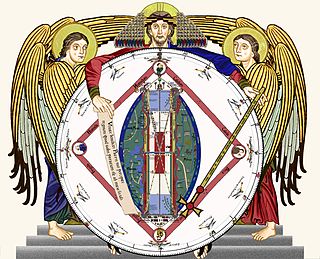
Cîteaux Abbey is a Catholic abbey located in Saint-Nicolas-lès-Cîteaux, south of Dijon, France. It is notable for being the original house of the Cistercian order. Today, it belongs to the Trappists.

The Cistercians officially the Order of Cistercians, are a Catholic religious order of monks and nuns that branched off from the Benedictines and follow the Rule of Saint Benedict. They are also known as Bernardines, after the highly influential Bernard of Clairvaux ; or as White Monks, in reference to the colour of the "cuculla" or white choir robe worn by the Cistercians over their habits, as opposed to the black cuculla worn by Benedictine monks.

The Basilica of Saint-Denis is a large former medieval abbey church and present cathedral in the city of Saint-Denis, a northern suburb of Paris. The building is of singular importance historically and architecturally as its choir, completed in 1144, is widely considered the first structure to employ all of the elements of Gothic architecture.

Suger was a French abbot, statesman, and historian. He was one of the earliest patrons of Gothic architecture, and is widely credited with popularizing the style.

Medieval architecture is architecture common in the Middle Ages, and includes religious, civil, and military buildings. Styles include pre-Romanesque, Romanesque, and Gothic. While most of the surviving medieval architecture is to be seen in churches and castles, examples of civic and domestic architecture can be found throughout Europe, in manor houses, town halls, almshouses, bridges, and residential houses.

The medieval art of the Western world covers a vast scope of time and place, over 1000 years of art in Europe, and at certain periods in Western Asia and Northern Africa. It includes major art movements and periods, national and regional art, genres, revivals, the artists' crafts, and the artists themselves.

Rose window is often used as a generic term applied to a circular window, but is especially used for those found in Gothic cathedrals and churches. The windows are divided into segments by stone mullions and tracery. The term rose window was not used before the 17th century and according to the Oxford English Dictionary, among other authorities, comes from the English flower name rose.

Gothic art was a style of medieval art that developed in Northern France out of Romanesque art in the 12th century AD, led by the concurrent development of Gothic architecture. It spread to all of Western Europe, and much of Northern, Southern and Central Europe, never quite effacing more classical styles in Italy. In the late 14th century, the sophisticated court style of International Gothic developed, which continued to evolve until the late 15th century. In many areas, especially Germany, Late Gothic art continued well into the 16th century, before being subsumed into Renaissance art. Primary media in the Gothic period included sculpture, panel painting, stained glass, fresco and illuminated manuscripts. The easily recognizable shifts in architecture from Romanesque to Gothic, and Gothic to Renaissance styles, are typically used to define the periods in art in all media, although in many ways figurative art developed at a different pace.

Hugh of Saint Victor, was a Saxon canon regular and a leading theologian and writer on mystical theology.

Romanesque art is the art of Europe from approximately 1000 AD to the rise of the Gothic style in the 12th century, or later depending on region. The preceding period is known as the Pre-Romanesque period. The term was invented by 19th-century art historians, especially for Romanesque architecture, which retained many basic features of Roman architectural style – most notably round-headed arches, but also barrel vaults, apses, and acanthus-leaf decoration – but had also developed many very different characteristics. In Southern France, Spain, and Italy there was an architectural continuity with the Late Antique, but the Romanesque style was the first style to spread across the whole of Catholic Europe, from Sicily to Scandinavia. Romanesque art was also greatly influenced by Byzantine art, especially in painting, and by the anti-classical energy of the decoration of the Insular art of the British Isles. From these elements was forged a highly innovative and coherent style.

Cistercian architecture is a style of architecture associated with the churches, monasteries and abbeys of the Roman Catholic Cistercian Order. It was heavily influenced by Abbot Bernard of Clairvaux, who believed that churches should avoid superfluous ornamentation so as not to distract from prayer. Cistercian architecture was simple and utilitarian. Although a few images of religious subjects were allowed, such as the crucifix, elaborate figures common in medieval churches were prohibited. Bernard noted their capacity for distracting monks in a famous letter. Early Cistercian architecture shows a transition between Romanesque and Gothic architecture. Later abbeys were constructed in Renaissance and Baroque styles, which were more ornate by nature.

The Abbey of Fontenay is a former Cistercian abbey located in the commune of Marmagne, near Montbard, in the département of Côte-d'Or in France. It was founded by Saint Bernard of Clairvaux in 1118, and built in the Romanesque style. It is one of the oldest and most complete Cistercian abbeys in Europe, and became a UNESCO World Heritage Site in 1981. Of the original complex comprising church, dormitory, cloister, chapter house, caldarium, refectory, dovecote and forge, all remain intact except the refectory and are well maintained. The Abbey of Fontenay, along with other Cistercian abbeys, forms a connecting link between Romanesque and Gothic architectures.

French Gothic architecture is an architectural style which emerged in France in 1140, and was dominant until the mid-16th century. The most notable examples are the great Gothic cathedrals of France, including Notre-Dame Cathedral, Reims Cathedral, Chartres Cathedral, and Amiens Cathedral. Its main characteristics were the search for verticality, or height, and the innovative use of the rib vault and flying buttresses and other architectural innovations to distribute the weight of the stone structures to supports on the outside, allowing unprecedented height and volume, The new techniques also permitted the addition of larger windows, including enormous stained glass windows, which filled the cathedrals with light. The French style was widely copied in other parts of northern Europe, particularly Germany and England. It was gradually supplanted as the dominant French style in the mid-16th century by French Renaissance architecture.

Early Gothic is the style of architecture that appeared in northern France, Normandy and then England between about 1130 and the mid-13th century. It combined and developed several key elements from earlier styles, particularly from Romanesque architecture, including the rib vault, flying buttress, and the pointed arch, and used them in innovative ways to create structures, particularly Gothic cathedrals and churches, of exceptional height and grandeur, filled with light from stained glass windows. Notable examples of early Gothic architecture in France include the ambulatory and facade of Saint-Denis Basilica; Sens Cathedral (1140); Laon Cathedral; Senlis Cathedral; (1160) and most famously Notre-Dame de Paris.
William W. Clark is a professor of art history in the medieval studies program at the Graduate Center at Queens College, City University of New York. He is a widely published expert on early medieval, Romanesque, and Gothic art and architecture.
Bernard of Clairvaux's Apologia ad Guillelmum was written in 1125 at the ostensible request of his friend and fellow monastic reformer, William of Saint-Thierry, and is the key document in the early twelfth century controversy over art, the greatest controversy over art to occur in the West previous to the Reformation.

Hugh of Saint Victor's The Mystic Ark (1125-1130) is a forty-two page description of the most complex individual work of figural art of the entire Middle Ages, a painting also known as The Mystic Ark.

Gothic cathedrals and churches are religious buildings created in Europe between the mid-12th century and the beginning of the 16th century. The cathedrals are notable particularly for their great height and their extensive use of stained glass to fill the interiors with light. They were the tallest and largest buildings of their time and the most prominent examples of Gothic architecture. The appearance of the Gothic cathedral was not only a revolution in architecture; it also introduced new forms in decoration, sculpture, and art.
Carolyn Marino Malone is an American medievalist and academic. She is professor of art history and history at USC Dornsife College, Los Angeles, California, with a PhD in Art History and Medieval Studies (1973) from the University of California, Berkeley. Her research interests are English and French Romanesque and Gothic architecture and sculpture. She has published books on sculptural finds at Canterbury Cathedral, the abbey of St Bénigne in Dijon, the façade of Wells Cathedral, and monastic life in the Middle Ages. She served as Vice-President (1996-1997) and President (1999) of Art Historians of Southern California; Domestic Advisor to the Board of Directors of the International Center of Medieval Art (1984-1987); and was on the Board of Directors of the Medieval Association of the Pacific (1986-1989). She is a member of the Society of Architectural Historians.
Deborah Kahn is an academic specialising in European Medieval art and architecture. After graduating from Sarah Lawrence College, she studied for her MA and Ph.D at the Courtauld Institute of Art. Working for George Zarnecki she helped organise the 1984 Hayward Gallery Exhibition, ''English Romanesque Art 1066 - 1200''. She later acted as a consultant on sculpture and conservation to Canterbury and Lincoln Cathedrals.
















